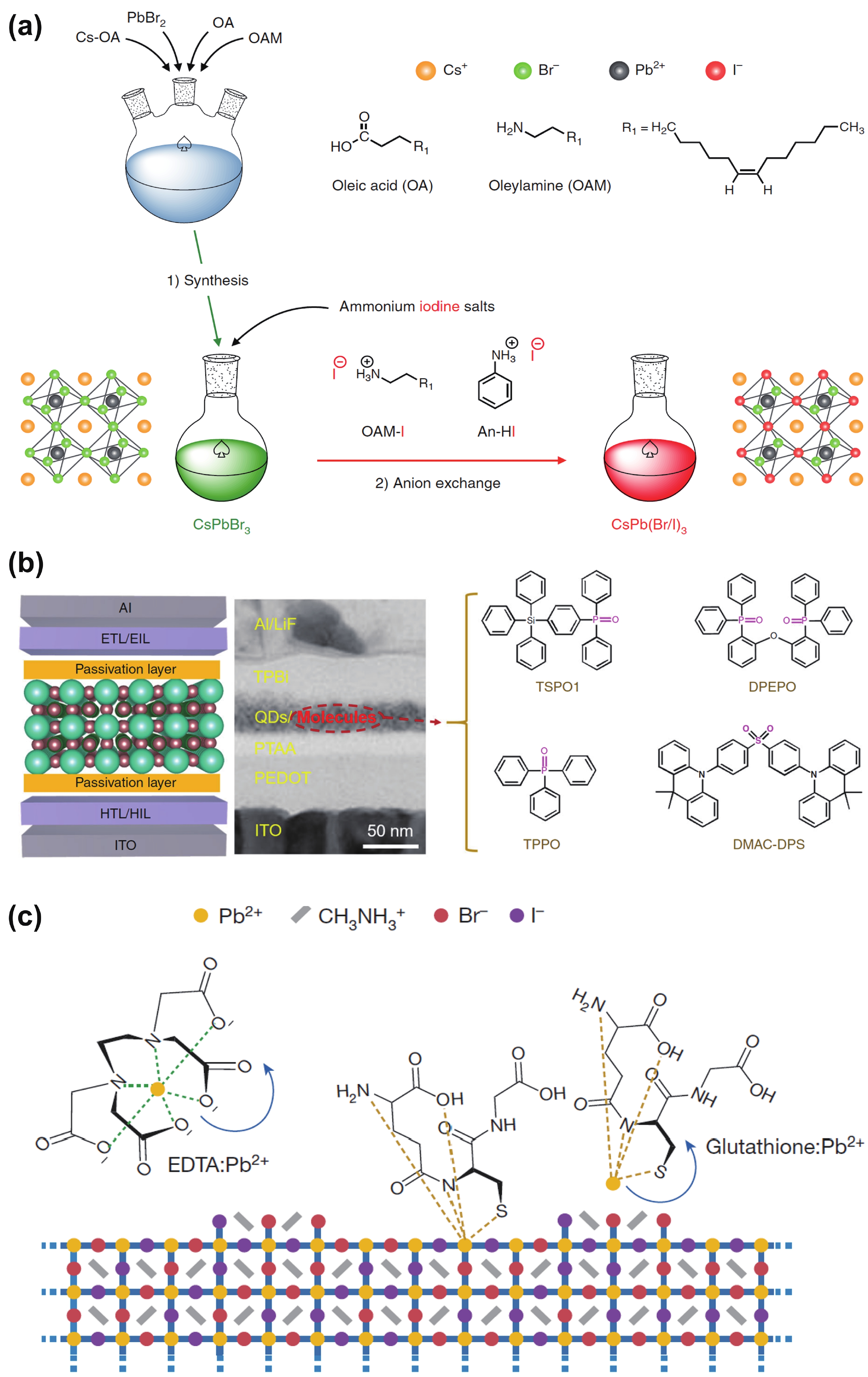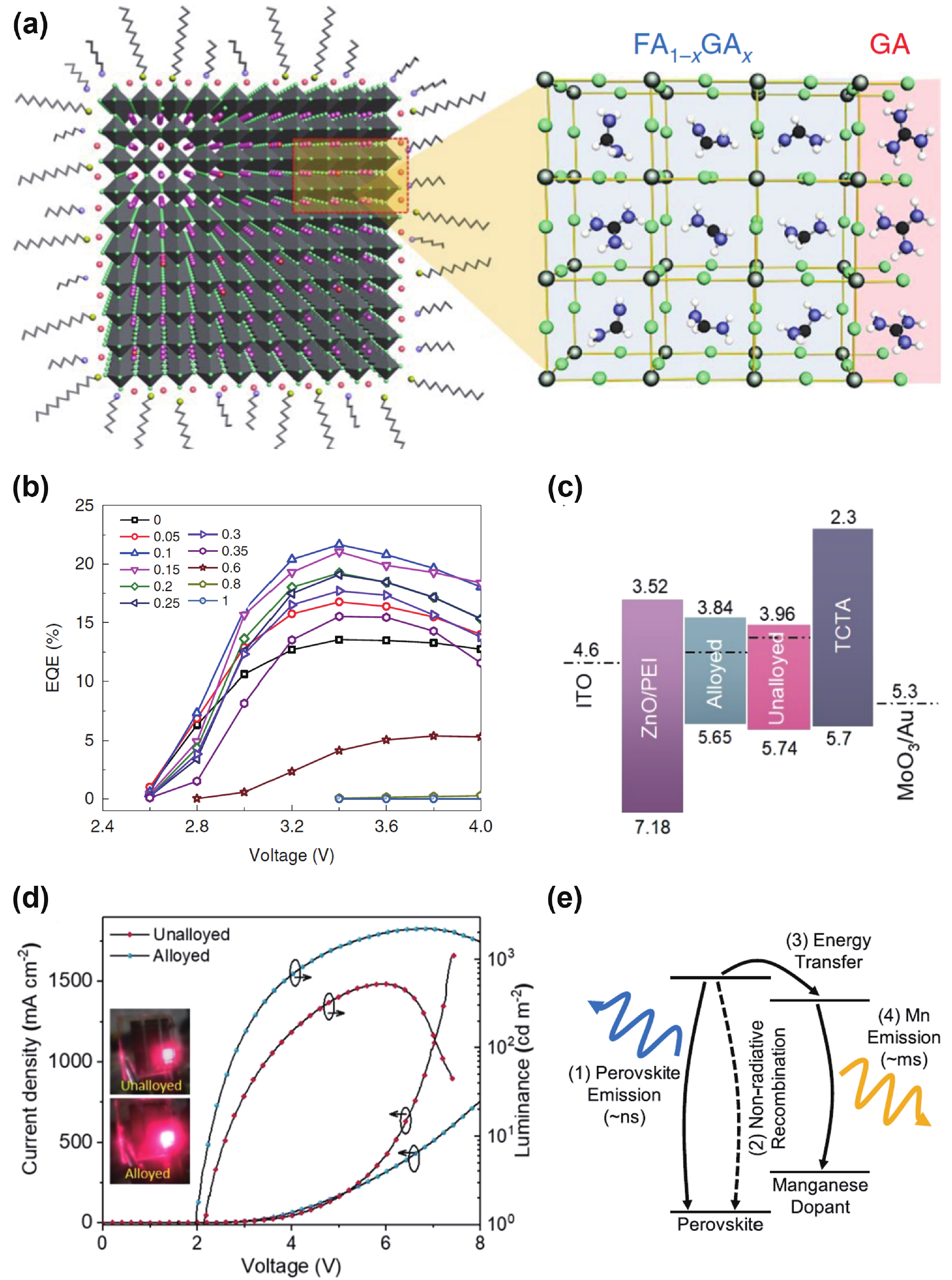| Citation: |
Xinyi Mei, Lixiu Zhang, Xiaoliang Zhang, Liming Ding. Perovskite nanocrystals for light-emitting diodes[J]. Journal of Semiconductors, 2022, 43(9): 090201. doi: 10.1088/1674-4926/43/9/090201
****
X Y Mei, L X Zhang, X L Zhang, L M Ding. Perovskite nanocrystals for light-emitting diodes[J]. J. Semicond, 2022, 43(9): 090201. doi: 10.1088/1674-4926/43/9/090201
|
Perovskite nanocrystals for light-emitting diodes
DOI: 10.1088/1674-4926/43/9/090201
More Information
-
References
[1] Protesescu L, Yakunin S, Bodnarchuk M I, et al. Nanocrystals of cesium lead halide perovskites (CsPbX3, X = Cl, Br, and I): Novel optoelectronic materials showing bright emission with wide color gamut. Nano Lett, 2015, 15, 3692 doi: 10.1021/nl5048779[2] Xiang H, Zuo C, Zeng H, et al. White light-emitting diodes from perovskites. J Semicond, 2021, 42, 030202 doi: 10.1088/1674-4926/42/3/030202[3] Mei X, Jia D, Chen J, et al. Approaching high-performance light-emitting devices upon perovskite quantum dots: Advances and prospects. Nano Today, 2022, 43, 101449 doi: 10.1016/j.nantod.2022.101449[4] Zhang L, Pan X, Liu L, et al. Star perovskite materials. J Semicond, 2022, 43, 030203 doi: 10.1088/1674-4926/43/3/030203[5] Song J, Li J, Li X, et al. Quantum dot light-emitting diodes based on inorganic perovskite cesium lead halides (CsPbX3). Adv Mater, 2015, 27, 7162 doi: 10.1002/adma.201502567[6] Liu Y, Li Z, Xu J, et al. Wide-bandgap perovskite quantum dots in perovskite matrix for sky-blue light-emitting diodes. J Am Chem Soc, 2022, 144, 4009 doi: 10.1021/jacs.1c12556[7] Wang Y K, Singh K, Li J Y, et al. In situ inorganic ligand replenishment enables bandgap stability in mixed-halide perovskite quantum dot solids. Adv Mater, 2022, e2200854 doi: 10.1002/adma.202200854[8] Zhang M, Zuo C, Tian J, et al. Blue perovskite LEDs. J Semicond, 2021, 42, 070201 doi: 10.1088/1674-4926/42/7/070201[9] Kim Y H, Kim S, Kakekhani A, et al. Comprehensive defect suppression in perovskite nanocrystals for high-efficiency light-emitting diodes. Nat Photonics, 2021, 15, 148 doi: 10.1038/s41566-020-00732-4[10] Shen H, Gao Q, Zhang Y, et al. Visible quantum dot light-emitting diodes with simultaneous high brightness and efficiency. Nat Photonics, 2019, 13, 192 doi: 10.1038/s41566-019-0364-z[11] Yang Z, Ding L. Ligand passivation yields long-life perovskite light-emitting diodes. Sci Bull, 2020, 65, 1691 doi: 10.1016/j.scib.2020.06.030[12] Li Y, Ding L. Single-crystal perovskite devices. Sci Bull, 2021, 66, 214 doi: 10.1016/j.scib.2020.09.026[13] Li X, Wu Y, Zhang S, et al. CsPbX3 quantum dots for lighting and displays: Room-temperature synthesis, photoluminescence superiorities, underlying origins and white light-emitting diodes. Adv Funct Mater, 2016, 26, 2435 doi: 10.1002/adfm.201600109[14] Tong Y, Bladt E, Ayguler M F, et al. Highly luminescent cesium lead halide perovskite nanocrystals with tunable composition and thickness by ultrasonication. Angew Chem Int Ed, 2016, 55, 13887 doi: 10.1002/anie.201605909[15] Dutta A, Behera R K, Pal P, et al. Near-unity photoluminescence quantum efficiency for all CsPbX3 (X = Cl, Br, and I) perovskite nanocrystals: A generic synthesis approach. Angew Chem Int Ed, 2019, 58, 5552 doi: 10.1002/anie.201900374[16] Hassan Y, Ashton O J, Park J H, et al. Facile synthesis of stable and highly luminescent methylammonium lead halide nanocrystals for efficient light emitting devices. J Am Chem Soc, 2019, 141, 1269 doi: 10.1021/jacs.8b09706[17] Zhang X, Han D, Chen X, et al. Effects of solvent coordination on perovskite crystallization. Acta Phys Chim Sin, 2020, 37, 2008055 doi: 10.3866/PKU.WHXB202008055[18] De Roo J, Ibanez M, Geiregat P, et al. Highly dynamic ligand binding and light absorption coefficient of cesium lead bromide perovskite nanocrystals. ACS Nano, 2016, 10, 2071 doi: 10.1021/acsnano.5b06295[19] Jia D, Chen J, Qiu J, et al. Tailoring solvent-mediated ligand exchange for CsPbI3 perovskite quantum dot solar cells with efficiency exceeding 16.5%. Joule, 2022, in press doi: 10.1016/j.joule.2022.05.007[20] Jia D, Chen J, Mei X, et al. Surface matrix curing of inorganic CsPbI3 perovskite quantum dots for solar cells with efficiency over 16%. Energy Environ Sci, 2021, 14, 4599 doi: 10.1039/D1EE01463C[21] Zhou Q, Qiu J, Wang Y, et al. Multifunctional chemical bridge and defect passivation for highly efficient inverted perovskite solar cells. ACS Energy Lett, 2021, 6, 1596 doi: 10.1021/acsenergylett.1c00291[22] Chen J, Jia D, Johansson E M J, et al. Emerging perovskite quantum dot solar cells: feasible approaches to boost performance. Energy Environ Sci, 2021, 14, 224 doi: 10.1039/D0EE02900A[23] Zheng C, Liu A, Bi C, et al. SCN-doped CsPbI3 for improving stability and photodetection performance of colloidal quantum dots. Acta Phys Chim Sin, 2021, 37, 2007084 doi: 10.3866/PKU.WHXB202007084[24] Yang Z, Qin C, Ning Z, et al. Low-dimensionality perovskites yield high electroluminescence. Sci Bull, 2020, 65, 1057 doi: 10.1016/j.scib.2020.03.015[25] Zhang D, Qin C, Ding L. Domain controlling and defect passivation for efficient quasi-2D perovskite LEDs. J Semicond, 2022, 43, 050201 doi: 10.1088/1674-4926/43/5/050201[26] Chiba T, Hayashi Y, Ebe H, et al. Anion-exchange red perovskite quantum dots with ammonium iodine salts for highly efficient light-emitting devices. Nat Photonics, 2018, 12, 681 doi: 10.1038/s41566-018-0260-y[27] Liu M, Wan Q, Wang H, et al. Suppression of temperature quenching in perovskite nanocrystals for efficient and thermally stable light-emitting diodes. Nat Photonics, 2021, 15, 379 doi: 10.1038/s41566-021-00766-2[28] Dong Y, Wang Y K, Yuan F, et al. Bipolar-shell resurfacing for blue LEDs based on strongly confined perovskite quantum dots. Nat Nanotechnol, 2020, 15, 668 doi: 10.1038/s41565-020-0714-5[29] Zheng X, Yuan S, Liu J, et al. Chlorine vacancy passivation in mixed halide perovskite quantum dots by organic pseudohalides enables efficient Rec. 2020 blue light-emitting diodes. ACS Energy Lett, 2020, 5, 793 doi: 10.1021/acsenergylett.0c00057[30] Chen J, Jia D, Qiu J, et al. Multidentate passivation crosslinking perovskite quantum dots for efficient solar cells. Nano Energy, 2022, 96, 107140 doi: 10.1016/j.nanoen.2022.107140[31] Xu L, Li J, Cai B, et al. A bilateral interfacial passivation strategy promoting efficiency and stability of perovskite quantum dot light-emitting diodes. Nat Commun, 2020, 11, 3902 doi: 10.1038/s41467-020-17633-3[32] Zhao H, Chen H, Bai S, et al. High-brightness perovskite light-emitting diodes based on FAPbBr3 nanocrystals with rationally designed aromatic ligands. ACS Energy Lett, 2021, 6, 2395 doi: 10.1021/acsenergylett.1c00812[33] Jia D, Chen J, Yu M, et al. Dual passivation of CsPbI3 perovskite nanocrystals with amino acid ligands for efficient quantum dot solar cells. Small, 2020, 16, 2001772 doi: 10.1002/smll.202001772[34] Hassan Y, Park J H, Crawford M L, et al. Ligand-engineered bandgap stability in mixed-halide perovskite LEDs. Nature, 2021, 591, 72 doi: 10.1038/s41586-021-03217-8[35] Bi C, Yao Z, Sun X, et al. Perovskite quantum dots with ultralow trap density by acid etching-driven ligand exchange for high luminance and stable pure-blue light-emitting diodes. Adv Mater, 2021, 33, 2006722 doi: 10.1002/adma.202006722[36] Hou S, Gangishetty M K, Quan Q, et al. Efficient blue and white perovskite light-emitting diodes via manganese doping. Joule, 2018, 2, 2421 doi: 10.1016/j.joule.2018.08.005[37] Zhang J, Zhang L, Cai P, et al. Enhancing stability of red perovskite nanocrystals through copper substitution for efficient light-emitting diodes. Nano Energy, 2019, 62, 434 doi: 10.1016/j.nanoen.2019.05.027[38] Wang H C, Wang W, Tang A C, et al. High-performance CsPb1– xSn xBr3 perovskite quantum dots for light-emitting diodes. Angew Chem Int Ed, 2017, 56, 13650 doi: 10.1002/anie.201706860[39] Yao J S, Ge J, Wang K H, et al. Few-nanometer-sized alpha-CsPbI3 quantum dots enabled by strontium substitution and iodide passivation for efficient red-light emitting diodes. J Am Chem Soc, 2019, 141, 2069 doi: 10.1021/jacs.8b11447[40] Shen X, Zhang Y, Kershaw S V, et al. Zn-alloyed CsPbI3 nanocrystals for highly efficient perovskite light-emitting devices. Nano Lett, 2019, 19, 1552 doi: 10.1021/acs.nanolett.8b04339[41] Chen C, Xuan T, Bai W, et al. Highly stable CsPbI3: Sr2+ nanocrystals with near-unity quantum yield enabling perovskite light-emitting diodes with an external quantum efficiency of 17.1%. Nano Energy, 2021, 85, 106033 doi: 10.1016/j.nanoen.2021.106033[42] Liu Y, Dong Y, Zhu T, et al. Bright and Stable light-emitting diodes based on perovskite quantum dots in perovskite matrix. J Am Chem Soc, 2021, 143, 15606 doi: 10.1021/jacs.1c02148[43] Tsai H, Shrestha S, Vilá R A, et al. Bright and stable light-emitting diodes made with perovskite nanocrystals stabilized in metal–organic frameworks. Nat Photonics, 2021, 15, 843 doi: 10.1038/s41566-021-00857-0[44] Wang C, Zhang C, Li R, et al. Charge accumulation behavior in quantum dot light-emitting diodes. Acta Phys Chim Sin, 2022, 38, 2104030 doi: 10.3866/PKU.WHXB202104030[45] Fan Q, Biesold-McGee G V, Ma J, et al. Lead-free halide perovskite nanocrystals: Crystal structures, synthesis, stabilities, and optical properties. Angew Chem Int Ed, 2020, 59, 1030 doi: 10.1002/anie.201904862 -
Proportional views






 DownLoad:
DownLoad:















